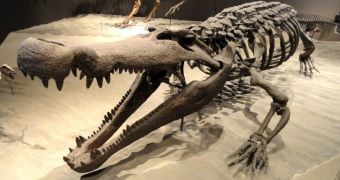Writing in a recent issue of the journal Historical Biology, a team of researchers detail the dining etiquette of crocodiles that lived thousands of years ago and that much enjoyed feasting on dinosaurs and on oversized mammals.
The study in question focuses on the feeding behavior of three different ancient reptile species, i.e. the Sarcosuchus, the Deinosuchus, and the Purussaurus, all of which are listed among the long lost relatives of modern crocodiles.
According to evidence uncovered thus far, the Sarcosuchus used to live in present-day Africa and South America and could grow to weigh as much as 8,000 kilograms (about 17,635 pounds) and measure 11.5 meters (37.7 feet) from head to tail.
The Purussaurus in the Amazon basin and the Deinosuchus in North America, on the other hand, have been documented to reach a weight of over 8,500 kilograms (18,740 pounds) and 10,000 kilograms (22,000 pounds), and a length of 12 meters (39.3 feet) and 13 meters (42.6 feet), respectively.
The researchers behind the paper in the journal Historical Biology explain that, according to evidence at hand, these ancient reptiles behaved much like present-day crocodiles during meal time, Live Science informs.
Thus, they used their jaws to grab hold of their prey and then started spinning their entire bodies. This enabled the ancient crocodiles to tear off flesh and even limbs, which they later swallowed whole.
Specialists explain that this behavior, which crocodiles continue to display these days, is known as death rolls and causes an animal's skull to be subjected to significant forces.
Of the three ancient crocodile species that this research project focused on, the Deinosuchus and the Purussaurus are the only ones believed to have been strong enough to handle a death roll without having their skulls injured in the process.
What's more, it would appear that, even in the case of these species, younger specimens were the ones that had an easier time tearing off the flesh and limbs of their prey using this technique. This is due to the fact that, because of their small size, they had an easier time spinning.
Judging by bite marks that scientists have until now discovered and analyzed, the Deinosuchus used to feed on both duck-billed dinosaurs known as hadrosaurs and on bipedal dinosaurs dubbed theropods.
The Sarcosuchus appears to have also had a sweet tooth for oversized dinosaurs, whereas the Purussaurus' menu chiefly included large mammals, sometimes even turtles and fish, that the reptile probably swallowed whole.

 14 DAY TRIAL //
14 DAY TRIAL //